Banana Lady, Hanoi | Oil on Polyester | 50x75in | 2012
Getting Real with Anthony Brunelli
“Anthony Brunelli is a world-renowned photo-realist painter from Binghamton, N.Y. … Early in his career, Anthony’s depictions of Binghamton, and the surrounding small cities of Upstate N.Y., captured the essence of the small town American landscape. Most recently, Anthony has expanded his subject matter to the urbanscape abroad. and has painted cities such as Paris, Florence, Prague, Zurich, and Hanoi to name a few….”
— from the artist’s website
***
With Mike Foldes Founder, Managing Editor
Tagazine:ony, your personal success as an artist and the presence of Anthony Brunelli Fine Arts gallery on State Street, have influenced and helped shape the resurgence over the past ten years or so, of the visual arts in Binghamton. What was it like for you growing up in Binghamton?
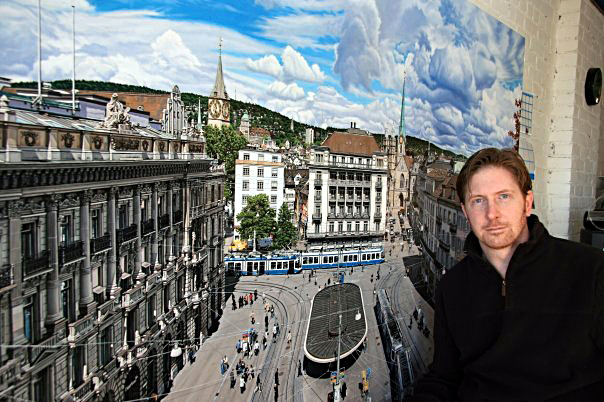
Anthony Brunelli with his painting, Paradeplatz, the famous square in Zurich
Anthony Brunelli: I grew up on the upper East Side of Binghamton on Riverview Ave., about a block away from Fairview Park and down the street from the Binghamton psych center. I am the middle child and have two brothers. I would split my time between drawing and being outdoors playing with friends and sports of all seasons. Baseball and ice hockey were my favorites. My family did not have the money for me to play organized hockey so I threw myself into baseball. I was a pitcher and a catcher in baseball. I guess that was the first sign of being a control freak!
I had a dream to be a professional baseball player or a cartoonist or both! I played baseball from kindergarten to high school. I began drawing when I was three years old. I loved the Peanuts comic strip and would copy Snoopy and other cartoon characters every waking moment. I became very proficient at hand eye coordination and could draw whatever I had in front of me. When I was in third grade I wrote to Charles M. Schulz, the creator of Peanuts comic strip and to my surprise he wrote me back. It was a real treasure and is still one of my prized possessions.
During lunchtimes, I would draw for my fellow classmates and they would give me their cupcakes and cookies. This was my first taste that my art could not only make people happy but earn me things. During my freshman year of high school I decided to attend Seton Catholic Central because I was protesting not being able to go to North High School. The newly consolidated Binghamton High School (BHS) seemed too intimidating and I thought I would have a better chance at playing baseball at Seton. Heartbreakingly, I was cut from the team.
Ninth grade was a miserable year for me. All my friends were attending BHS and I did not know anyone at Seton and found myself on the other side of all the cliques. To make matters worse, I had to take the bus home that stopped at BHS where all my friends would get on, wearing jeans and T shirts while I was wearing my dress clothes and tie. They seemed so happy and were having a great time. I was devastated. It felt like the longest year of my life and I found myself getting more and more detached. I no longer would speak unless spoken to. I would isolate myself and draw. I drew whenever and on whatever I could that year. It became my solace. I then transferred to BHS for the sophomore year. I was able to make the BHS JV baseball team. I was only allowed to pitch one game − the game against Seton. We won.
Although I did have my “revenge”, I was hardly playing that year. When I did play, I was relegated to right field and I once again felt like I was on the wrong side of the clique with this particular coach. It became apparent that I needed to make art, my front-and-center passion. It was the only thing that I felt like I could control without any interference from anyone or anything.
My love of Downtown started in my early years. My mother and grandmother would take me on the bus and we would shop at Fowler’s, Stephen’s Square and eat at the lunch counter at Woolworth’s. There were very few shopping plazas at that time, and no Oakdale Mall. I always marveled at the architecture of Downtown Binghamton and loved going in and out of the stores in all kinds of weather. Christmas time was particularly memorable, the lights, decorations and the Fowler’s department store Santa. People seemed so happy and personable. I am fortunate that I was able to catch the tail end of Downtown’s heyday.
Q) Were your parents artists? Where did you get the encouragement to make art, as opposed, let’s say, to being an engineer or physician?
A) My mother was an artist. She was always creating something and always had a dedicated “art” room, where I would spend hours with her. She turned down a scholarship to go to an art school in Boston and instead got married and started a family. Both of my parents always encouraged anything I or my two brothers did. Whether it was attending my games or scraping up money to send me to Saturday art classes at Roberson, there was always a feeling of support. I never heard, “You can’t make a living at art.”
Q) Your gallery is presently managed by your brother John, who is also very involved in the arts in Binghamton. What prompted you to get into the gallery business, and how much are you involved in day-to-day operations?
A) Nine months after opening, the whole Marla1 phenomenon happened, and my gallery was on the international radar. Newspapers from all over the world, and shows like 60 Minutes, Today and Inside edition were doing stories. A young filmmaker made a documentary that went to Sundance Film Festival and was bought by SONY pictures and then released to the movie theaters.
Thankfully, John was not particularly loving life in NYC and what he was doing and decided to come back to Binghamton and help me. John and I are now partners in the gallery. John runs the day-to-day operations. He is the managing partner. I handle some of the finances and the bills. He is responsible for the curation of the shows and finding new artists. We bounce a lot of ideas off each other and we started participating in international art fairs. These fairs are very time consuming and expensive, but in today’s art-buying climate, a “must” to attract new clients.
We still want a strong presence in Binghamton and we are not looking at watering down our program for the crowd here. What we have found is that there are some very sophisticated art collectors in this area and we enjoy cultivating these relationships. We are also cognizant of finding and nurturing local talent. It is a must that when this happens, the artists only show locally at our gallery. Our mission is to cultivate and represent talented artists with their careers, and not solely on art as a commodity.
Q) How did you come to photorealism? Have you experimented or worked in other styles or forms? Sculpture?
A) Since my early days copying the comics, representational art has always been my passion. Early on, I wanted to be a cartoonist. It changed to advertising, illustration and then fine arts. When I was in tenth grade, my high school art teacher, Dave Menichiello, took our class on a trip to NYC. We went to some galleries and when I walked into Pace Gallery, in SoHo at the time, I was overwhelmed by nine-foot portrait paintings by the artist Chuck Close.
They looked like large black and white photographs. When I got up close to them, I saw that he did them all with his thumbprint and stamp pad ink. It blew me away. He happened to be there that day and I met him and asked if he would pose in front of one of his paintings for a picture. He gladly did and that photo still hangs in my studio here in Binghamton. As soon as I got home I went to the bookstore and bought every book on him that I could, which then led me to the Photorealism movement.
In college, I did what was required, but I knew that I wanted to be a photorealist painter. Nothing compared and I imagine that I was a professor’s nightmare, because it was pretty apparent that this is all I wanted to do.
Q) You attended the Columbus College of Art & Design (CCAD). How did you like living in Columbus, and why did you leave Columbus to move back to Binghamton to earn your BFA?
A) I received a scholarship out of high school to attend CCAD. I started the Freshman year there but circumstances lead me back to Binghamton and I would learn that my then girlfriend was pregnant. Back in Binghamton, I began working three jobs, got married and kept the distant dream alive.
After two years of this, I was watching a TV program that showed downtown Columbus and started to get the pangs to continue my art degree. I called up the college and they informed me that they would still honor my scholarship. It took a lot of convincing my then-wife, but we departed for Columbus with a one-year-old child in tow.
While I was attending Columbus College of Art and Design, I picked up oil painting for the first time. I had tried when I was in high school but got very frustrated with it, not to mention the mess and the expense. One of my professors there, Ernie Viveiros, was painting realistic urban landscapes of Chicago. He would invite me to his studio that was in a large, old warehouse in downtown Columbus, and he showed me his painting process.
I visited and met many artists and saw their studios. Ernie showed me how he took the photographs, pieced them together, projected them with an old opaque projector and then started with underpaintings. I never looked back. I knew the day I went to his studio that I would become a fine arts painter. The decision to come back to Binghamton after my freshman year was an extremely tough one. I was thriving, my technique improved immensely while being around so many talented artists and creating art constantly. The professors were all working in their respective fields and I could feel for the first time that art really could become a career.
On the other side of the coin, I had to deal with a very homesick wife, a continually sick baby and very long days that would turn into long nights as my wife would go to work when I got home. I would be relegated to watching my daughter and doing the mounds of homework from my ten classes a week. It was wearing on me both physically, mentally and emotionally.
Ironically as the school year came to a close, my wife started making friends at work and said she would stay if I wanted, but if we went back to Binghamton that would be the final move. I talked it over with my professor Ernie and he could see it wearing on me. He gave me the best advice anyone could at the time. He said that it didn’t matter where I decided to go because it is always what you make of it. I would like to say I never looked back, but when I got back to Binghamton I felt I made the wrong decision, and decided I would give it a whirl on my own for my sophomore year at CCAD. Needless to say, that experiment only lasted 10 days.
Q) Who were your primary artistic influences, those who helped you develop both your eye and your style?
A) First, of course, would be my mother. She was my first introduction to art and she was always creating. Charles M. Schulz was definitely a big part, as well. I read his biography at an early age, which showed me that pursuing art as a livelihood was not out of the realm of possibility. Charlie Brown was his alter ego and Snoopy was who he wished he could be. Through his art he became them all. That really appealed to me and made me realize that I could be whoever I wanted with my art.
I was fortunate to have Dave Menichiello and Tom Dooley as high school art and photography teachers. Dave always encouraged, and was responsible for the NYC trip where I met Chuck Close, and led me to the Photorealism movement. Tom Dooley showed me that presentation of an art piece should always be of the highest standard; If you are not happy with something, then your audience won’t be either.
Ernie Viveiros was probably more closely responsible for what I do now, and we are great friends still today. As a student under Ernie, I realized how close I was to achieving my dream, even with the added pressure of being a young, married father working three jobs. Ernie is now an artist that we represent in Anthony Brunelli Fine Arts and we have sold a number of his paintings, so it has come full circle.
Norman Rockwell had an innate ability and talent that I am not sure we will ever see the likes of again. For so long he did not get his due, but I am happy that he is now known as one of the leading realist painters in America. I always marveled at the light in an Edward Hopper painting. I loved everything about Van Gogh, especially his passion for art, even at the ultimate cost. Frederick Church showed me the power and majesty of a large realist landscape and Salvador Dali created magic on the canvas.
These are just a few of my artistic influences. All of them shaped my vision as an artist. I realized very early on that to be a great artist you did not have to break new ground or do something novel. The real test was to take these influences and shape them into your own. Finding myself in each one of them is like a life-long puzzle.
Q) At what point did you know you could make a living as an artist, without depending on other activities to support yourself −such as three jobs while going to school and parenting?
A) My early days in grade school showed me that my art could get me things — attention, approval, cupcakes and gift certificates for art supplies. That is what planted the seed. But, going down to NYC and showing my work to Meisel, having him take me on as a gallery artist and then selling my first painting two weeks later for $12,000 back in 1993 was when it became real.
I was a month away from graduating from Binghamton University, my second daughter was just born and I was taking education credits on the side to teach, but that all changed with that first sale. Meisel called me up and asked if I was sitting down. I said yes and he informed me that he sold the painting and it was going into a very important collection. I should quit all my jobs and just paint full time. I have never looked back.
Q) What advice do you have for other artists trying to make a living through their art?
A) My advice is and always will be, do not chase money! Do what is your passion and live simply. Art is a way of life. If it is a passion, if you work on your craft and stay humble, you will be successful. I am sure my definition of success is different than most. Freedom, loving what you do, never punching a time clock and not having a limit on your potential is the definition of success to me. The money, and everything else for that matter, will follow.
I believe it is like that for just about anything in life. Technology is expanding rapidly. More so than in any time in the history of human beings. Because of this, there is a lot of detachment between human connections, and an incredible amount of fear and anxiety. In my opinion, it will be art that can usher in a sense of inner peace and a more calm sense of being.
Many people are turning to art for healing. Will this equate to someone who is looking to make a living at it? I am not sure, but it will provide for a space to make better decisions, create better work and get back in tune with the true purpose of why we are here. Stop chasing the next great thing and go deep inside. Meditate, walk in nature, have compassion and learn to love. Do something that will make life better on this planet, whether that means creating it or by just being a better person. That will be the path to true success.
Q) Many people regard photorealistic painting to be an attempt to capture images that photography itself can do better. Others see it as a severe approach to artistic expression requiring more in the way of draftsmanship skills, with results that are devoid of emotional content. How would you respond to that?
A) Putting a urinal on the wall. Is that art? Dripping paint on a canvas. Is that art? Putting a shark in a tank of formaldehyde. Is that art? It is ALL a matter of perception and taste. During this time anything is called art. There no longer is a quality criteria for art and you don’t need any specific training. Art is a commodity and a lot of people are just as detached when they purchase a piece of art as if they were buying a stock certificate. Art has always reflected the society it was created in.
It is no different now. Anything goes. Who calls it art? What is quality? The Emperor’s New Clothes? Not to mention, artists have always used whatever technology they have available to them. We see that with the cave paintings of Lascaux, with Vermeer and his camera obscura, with Degas and his use of early photography for his compositions.
I have always striven for technical ability with emotion. I, personally, want my work to convey joy. I have joy when I am painting and I hope that it comes across to the viewer. I never really cared what most critics have said. Firstly, I paint for myself. If it is any other way it cannot be my truth, and then what is the point? Who would want to create someone else’s truth?
Q) Can you tell us something of your process? How do you construct the images you will transfer to the canvas? Do you start with photographs you take, or sketches you make? Do you come back to the studio with an idea of what you will paint, or does that epiphany take place when you review your “studies”?
A) I love the panorama. I have always been drawn to this view. Before the advent of the iPhone, the panorama was unique. Nowadays everyone can do it on their phones and with much more success and ease than what I have had to do. I use digital photos and usually take between 50-100 shots of a scene and stitch them together on Photoshop. Before digital, I used to manually cut and paste the photographs.
I draw the final image onto the canvas using a combination of the grid technique as well as a digital projector and start with a very detailed under painting and then go over it as many times as needed. It can take anywhere from 4- 12 months to complete a painting depending on the size. Paintings are usually 5-7 ft. in length.
I have never been into sketching. With Photorealism, you pretty much know what you are going to get when you have the photograph complete. For me, the “sketching” is when I am there at the location doing the photography. I look at a scene from many angles and in different kinds of light. I take massive amounts of photos so that I can have many options. In this way, when someone says, “Why not just take a photograph?”, this illustrates the reason. A photograph captures a moment in time; my paintings catch moments of a particular scene the way I want to see them.
I am not a camera − that is a machine that has limitations. My hope is that my essence comes through in my paintings. I usually know right away, at the moment of photographing it, if a particular scene is worthy of a possible ten-month time commitment. When the hair on my arms begin to stand up at a particular location, I know.
Q) What is your preferred medium? Acrylic, oil? Do you ever paint with watercolors or pastels for studies of your larger works? Any special linen/canvas, and why? Do you stretch your own (canvases)?
A) I am exclusively an oil painter. Once I discovered oil painting, I was ruined for other mediums. My paintings take so long to complete that I really do not want to invest the time in trying out other mediums. I usually just want to do something completely different than art. Maybe in the future that will change. I am open to letting myself go where I need to. I usually stretch my own work, but to be honest, that is becoming a pain in the butt.
A few years back I stretched the canvas first and then began painting on it, but I found that I almost always wanted more space as the painting began. I decided that I would just paint on the canvas unstretched, tacked to large piece of Masonite™, with plenty of blank canvas surrounding the image to increase the size as needed and then stretch it after it was complete. It is a little more difficult, but it is less constrictive, and a much better way of working for me. I usually use a very smooth portrait linen, but have been experimenting with a polyester canvas that many of the archivists are recommending. It is more stable and stretches easier.
Q) You’ve traveled widely to capture the images of cities, towns and neighborhoods around the world, from Binghamton to Prague to Vietnam. What did you find most interesting?
A) The thing that strikes me the most when I look back at my travels, is that wherever I go, I usually find a piece of Binghamton there. I do not have to stray too far from the scenes I originally started with when I first began painting Binghamton. The things I look for, intersections, aerial views, centers of commerce where people mill about, and now market scenes, are similar, but have a different cultural look to them.
The main thing that changes is the light. I particularly like Vietnam, especially Hanoi. It was explained to me that virtually the whole country of Vietnam hugs the coast and the cloud formations that form over the Gulf of Tonkin make the light bounce off the sea into the clouds and then back to the land. There is always a “glow” even when it is cloudy.
Binghamton, especially in the summer is much more chromatic, as you have blue skies and the green hills. But in winter it is completely different and usually washed out and depressing. Manhattan takes on grayish mid-tones and is not that chromatic with all the smog and pollution. Light is a very important part of painting for me, hence why I like Hopper so much.
Q) Are you teaching, and if so, can you tell us something about what that’s like for you?
A) I am not teaching. I taught a few adjunct classes at Broome Community College a few years ago, for about 5 years, and that was enjoyable. I wanted to give back to the community and told myself when it started feeling like “work” and I was thinking about being somewhere else while I was in the classroom, that is when I should stop.
For me, I had expectations that I would touch every student somehow and that my unbridled passion would take over. Most students were eager, but the few who were not drained me at the end. Some students that age probably should not be in college. It is a waste of time for them and the instructors, as well as the parents who are paying. That is okay, though. I think that more people should honor their truth in that particular moment in their life. As a society, we have been so trained to follow this very rigid path, often to our own detriment. We are constantly living a life around other people’s expectations.
I had some really great students though. Still to this day I hear from them and see that they have parlayed their art into a livelihood. One of the best experiences was Mason Mastroianni, grandson of Johnny Hart, who took over the comic strip B.C.. Mason is one of the most talented, sensitive artists I have ever encountered. It was a joy to have him as a student then, and now to have him as a peer. I have and will take on certain artists and help them if I can. It usually is not a strict classroom setup, but unique to each and beneficial to both them and myself.
One example is an artist from Seattle, Rich Heisler, who is one of our gallery artists. Rich was a budding painter who was painting in the photorealist style. He was good and dedicated, but I saw a flaw that I knew would prevent him from getting to the next level. He asked for my honest opinion and I told him the truth. He was painting in acrylic, but also using colored pencil in certain areas. As an artist, and someone who encountered this problem early on, I knew why he was doing this. He used the colored pencil in areas where he was not confident enough to paint.
I asked him if he had ever tried to use oil paint and that it could be the medium that got him over the hump. He asked if I could help him. I obliged and he came to Binghamton to paint here in the gallery for a few weeks. I told him if he was willing to go to the expense and trouble to do that, he needed to be prepared for it. I was going to be very hard and critical and no sugarcoating anything and that he would have to immerse himself thoroughly. It became affectionately known as ” Brunelli’s art boot camp” !
He paid for a flight to Binghamton and we had him set up in the gallery and he painted night and day. He left exhausted and drained, but has since produced some of the best paintings of his career. After a month he went from “hating” me to thanking me.
Q) Many of your works are reproduced as giclées, which are available through your gallery. For those who may not be familiar, can you tell us a bit about the process and what goes into a quality print?
A) Basically any painting that I have done can be made into a print. With the advent of digital printing, everything is print on demand. I think that is what you mean by giclée. There are not very many giclée printers, if any at all anymore. Although in my opinion I think the quality was much better than most digital printers. Giclée printers are more cumbersome and very expensive to maintain. Parts are harder and harder to come by. The giclée printers sprayed the ink on as it rolled over a drum that spun around. It could take up to an hour to print one image.
With the digital printers it is more like a large glorified ink jet printer. The print will be only as good as the image when given to the printer and the calibration of the machines to the mode of the file that the image is saved in. The great thing about digital printing is the amount of different substrates that you can print on, even canvas. For me, the prints have always been a way to reach a wider audience and make it more affordable to own something of mine. I never dictated the prices of the originals, that was all controlled by the gallery. I have always been very surprised at where it has gone. I could say that it took over a decade’s worth of time before I could even be able to afford to keep one! Which to this day I have never done. I have been fortunate that every painting that I have ever created has sold. I am truly humbled by this fact. I am blessed.
Q) Do you have any shows coming up? Where can people see your original works?
A) I am participating in a group show at the Louis K. Meisel Gallery in NYC in November of this year. Currently, I am in a major European Museum tour of Photorealism. It has been touring for a few years now. The response has been so great that many of the museums throughout Europe continue to request it, and the tour has continued long after its original end date. It was in Madrid at the Thyssen Bornemisza in the Fall of 2013 and it broke attendance records. The museum made more money on that show than any others prior.
I went to the opening and could not believe the lines out the door every day. Not bad for a country that is in economic doldrums. It has been in Great Britain, Germany, Spain and is slated to continue on to Luxembourg, Estonia and The Netherlands, at this point. There is talk of it coming to the US after that. I will be participating in Art Miami this December, not only as an artist with the Meisel gallery but my gallery in Binghamton will have a presence there, as well. There is another Photorealism group show scheduled at the Parrish Museum in the Hamptons in 2017 that I will be a part of also. There usually is a piece or two at the Meisel Gallery in SoHo, and I have been in discussions about a 25-year retrospective in 2018.
Q) Is there anything you’d like to say or add that we may not have addressed?
A) Over the past few years, I have come to the realization that who I am is not an artist. It used to define me, but although that is a part of me, it no longer defines me. My Mother died in February of 2014 from complications of eight years’ worth of Stage IV Multiple Myeloma cancer. Months before this, I sustained a pretty bad ice hockey collision that took many months to heal. I have never been hit so unexpectedly hard in my life.
I landed on my neck and am thankful I did not break it, but had whiplash, among other complications. I soon developed PTSD and had crippling anxiety. It was at my mother’s burial that I felt something on my neck, which turned out to be squamous cell skin cancer. It was my trifecta, in less than a span of six months. Needless to say, life took me on an unexpected journey. I came face to face with the darkest realm of my life. I could not find the off switch for those pesky negative thought patterns.
I am grateful that I have been cultivating inner strength my entire life. I needed every ounce of that strength to get through this period. I was humbled and discovered a new level of compassion. I was taken on this journey and led to discoveries about fear, life-altering change, suffering, death and the existence of life. Why am I here? What I learned was that life is the combination of mind, body and spirit working in conjunction. I learned that being an artist is not my identity, it is what I do in the physical realm. I learned that ALL change is for the better, because life is change.
I learned that I am also not my thoughts. Many of this world’s problems stem from this egoic way of thinking. We are all lost in our own thoughts, all the time. We have allowed the process of the mind to use us, instead of the other way around. I also learned that in the end, all there is, is love. ( Strike up the Beatles!). I came to this understanding by allowing myself to sit with my pain (physical, emotional and spiritual). I refused to go on any type of drug, instead choosing to feel the pain and believed that there had to be a natural way to heal.
I wanted it out of me, not masked by some drug, only to get hidden in the recesses somewhere in the body and come out again when least expected. I realized that there had to be a purpose for this suffering and that I was only going to find the answer inside of myself. Exercising, meditating, yoga, reading and talking with close friends and relatives became my prescription. It was not easy and I had to have faith that “This, too, shall pass”.
Life is about experiences, finding joy, creating and making sure that love is the dominant emotion in my life. It is a far cry from what I thought and what society pounded in my head incessantly.What I was striving for before − Success, money, fame, material things… These things are okay as long as they are not the purpose for my life. One of the greatest quotes that I read was, “What you want out of life, make happen for another.” These are the words that I live for. That is who I am.
Thank you, Tony.
Note 1: Marla Olmstead, 4-year-old child abstract painter. https://en.wikipedia.org/wiki/Marla_Olmstead
Anthony Brunelli / Snapshots
Brunelli showing Queen Marguerite of Denmark his painting of Binghamton at ” This is America” group show at the Aarhus Denmark Museum in 2001.
Photorealists and dealers at the opening of the launch of the latest book on Photorealism in the Digital Age in November 2013. L. To R. Kneeling : artist Don Jacot, artist Davis Cone, Louis Meisel, artist Hubert Lartigue, artist Sharon Moody, standing : artist Tom Blackwell, artist Robert Neffson, artist Bertrand Meniel, artist Robert Gniewek, Susan Meisel, artist Randall Rosenthall, artist Bernardo Torrens, Brunelli, art dealer Frank Bernarducci, Gallery director Liz Harris, artist Nathan Walsh, artist Simon Hennessy.
***
***
About the interviewer:
Mike Foldes is founder and managing editor of Ragazine.CC. You can read more about him in About Us. This e-interview was conducted in September 2015.
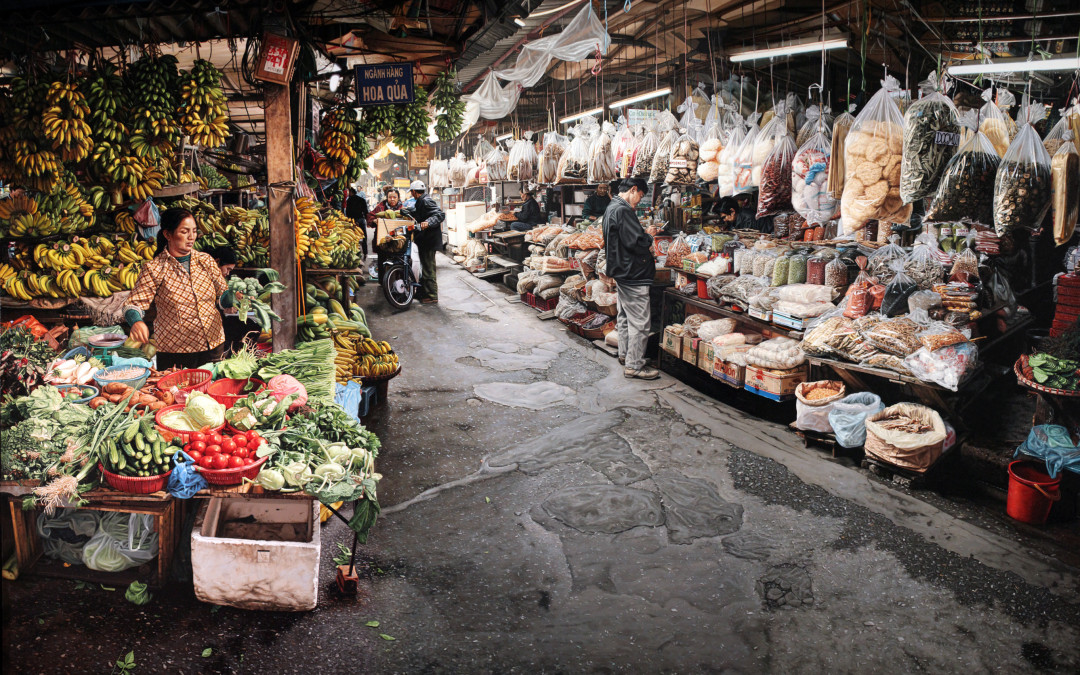
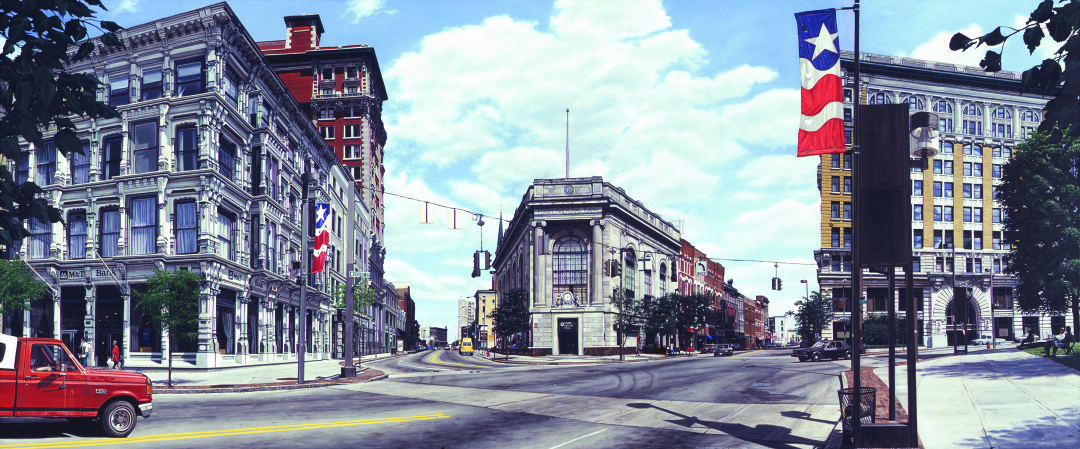
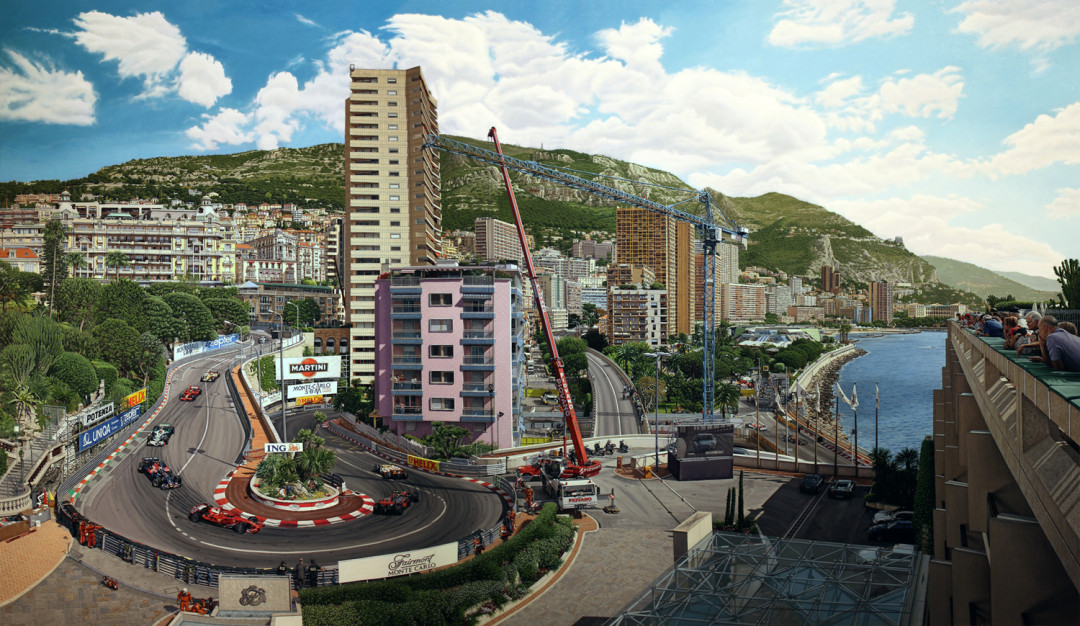
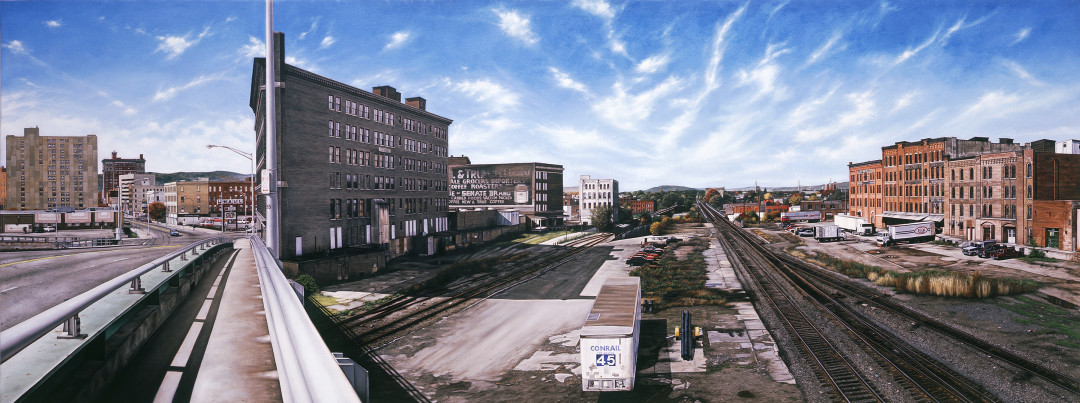
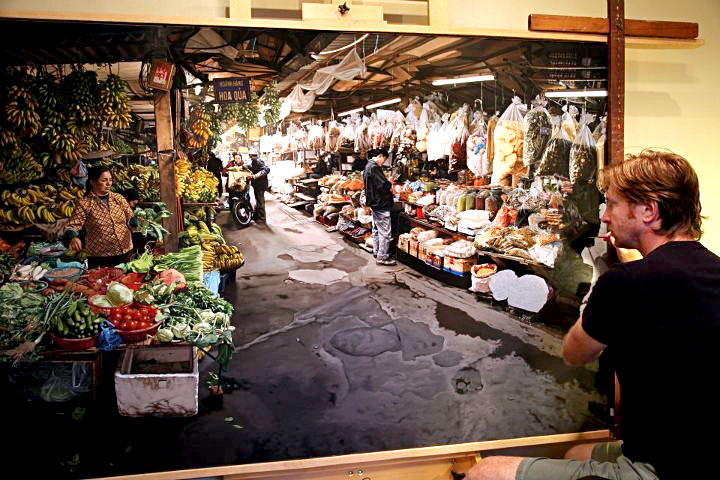
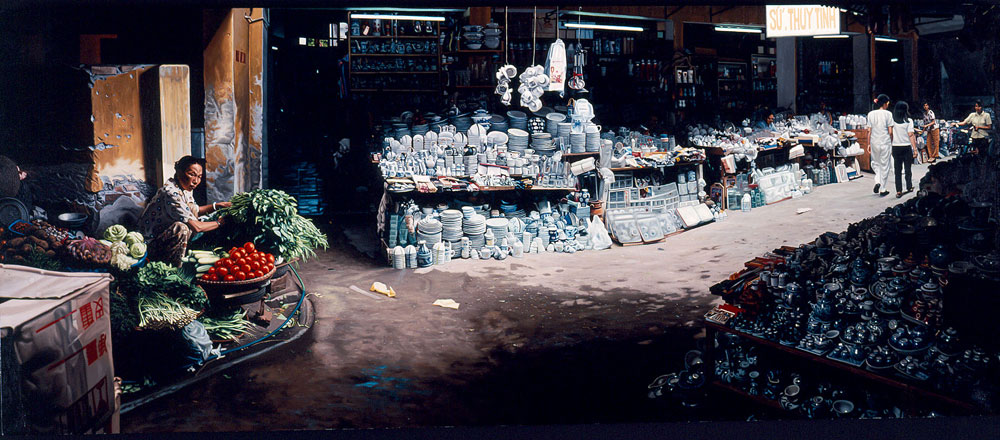
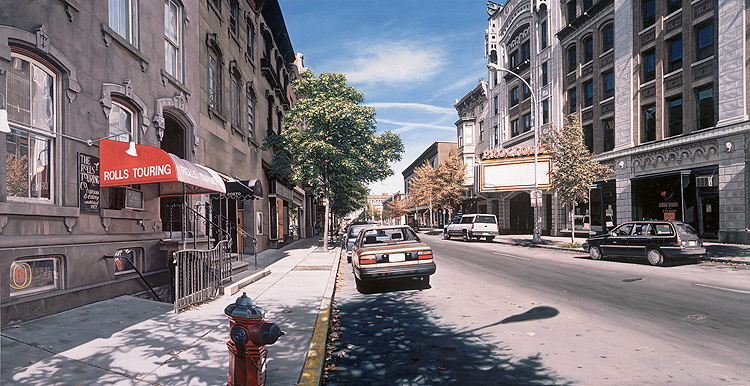

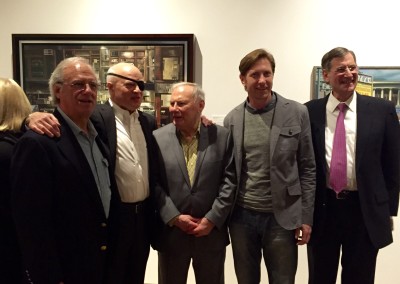
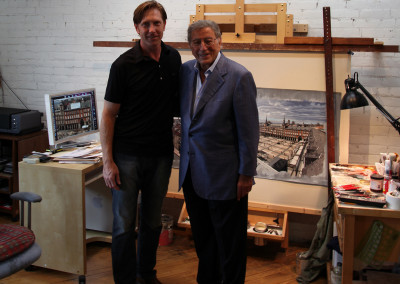
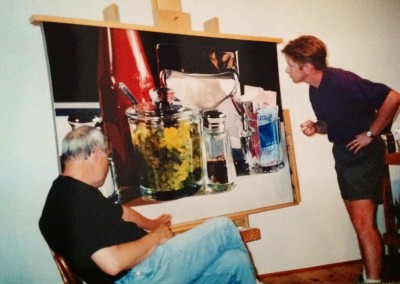
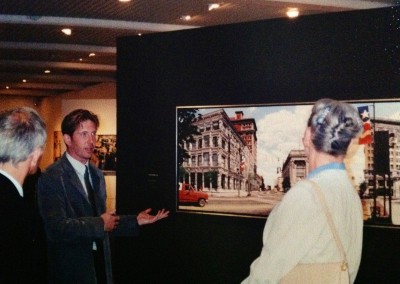
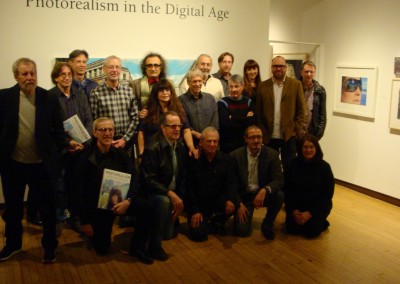
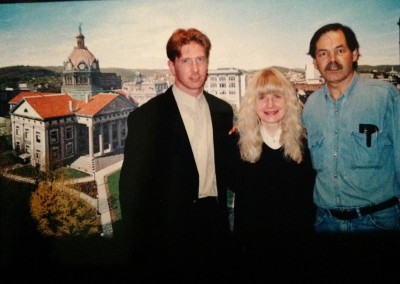
Recent Comments